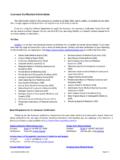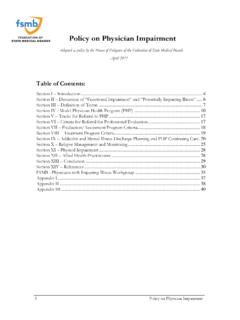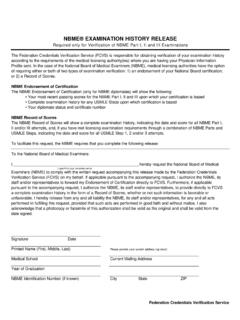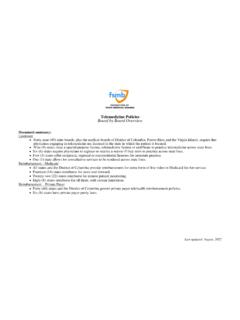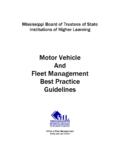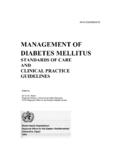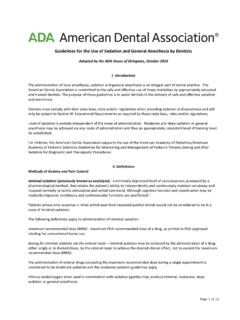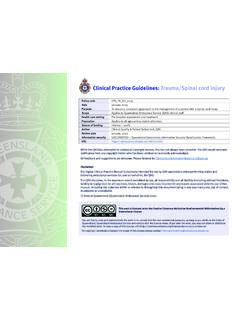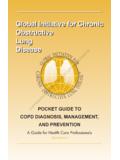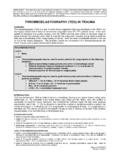Transcription of Guidelines for the Chronic Use of Opioid Analgesics
1 Guidelines for the Chronic Use of Opioid Analgesics Adopted as policy by the Federation of State Medical Boards April 2017. INTRODUCTION. In April 2015, the Federation of State Medical Boards (FSMB) Chair, J. Daniel Gifford, MD, FACP, appointed the Workgroup on FSMB's Model Policy for the Use of Opioid Analgesics in the Treatment of Chronic Pain to review the current science for treating Chronic pain with Opioid Analgesics and to revise the Model Policy as appropriate. To accomplish this charge, the workgroup conducted a thorough review and analysis of FSMB's existing policy document and other state and federal policies on the prescribing of opioids in the treatment of pain, including the March 2016 CDC Guideline for Prescribing Opioids for Chronic Pain ( ). In updating its existing policy, the FSMB sought input from a diverse group of medical and policy stakeholders that ranged from experts in pain medicine and addiction to government officials and other thought leaders.
2 Over the course of the last 12 months, the workgroup met on several occasions to examine and explore the key elements required to ensure FSMB's policy document remains relevant and is sufficiently comprehensive to serve as a prescribing guideline and resource for state medical and osteopathic boards and clinicians. This policy document includes relevant recommendations identified by the workgroup, and is in keeping with recent releases of advisories issued by the CDC and FDA. This policy is intended as a resource providing overall guidance to state medical and osteopathic boards in assessing physicians' management of pain in their patients and whether Opioid Analgesics are used in a medically appropriate manner. FSMB Guidelines FOR THE Chronic USE OF Opioid Analgesics . Section 1 PREAMBLE. The diagnosis and treatment of pain is integral to the practice of medicine2,18-21. In order to implement best practices for responsible Opioid prescribing, clinicians must understand the relevant pharmacologic and clinical issues in the use of Opioid Analgesics and should obtain sufficient targeted continuing education and training on the safe prescribing of opioids and other Analgesics as well as training in multimodal treatments.
3 1. Section 2 FOCUS OF Guidelines . The focus of the Guidelines that follow is on the general overall safe and evidence-based prescribing of opioids and treatment of Chronic , non-cancer pain with the specific limitation and restriction that these Guidelines do not operate to create any specific standard of care, which standard must depend upon fact-specific totality of circumstances surrounding specific quality-of-care events. The Guidelines recognize that there is not just one appropriate strategy to accomplish the goals of these Guidelines . Effective means of achieving the goals of these Guidelines vary widely depending on the type and causes of the patient's pain, the preferences of the clinician and the patient, the resources available at the time of care, and other concurrent issues beyond the scope of these Guidelines . These Guidelines that follow do not encourage the prescribing of opioids over other pharmacological and nonpharmacological means of treatment but rather the Guidelines recognize the responsibility of clinicians to view pain management as essential to quality of medical practice and to the quality of life for patients who suffer from pain.
4 Finally, the Guidelines that follow are not intended for the treatment of acute pain, acute pain management in the perioperative setting, emergency care, cancer-related pain, palliative care, or end-of-life care. These Guidelines may apply most directly to the treatment of Chronic pain lasting more than three months in duration or past the time of normal tissue healing, however many of the strategies mentioned here are also relevant to responsible prescribing and the mitigation of risks associated with other controlled substances in the treatment of pain. Section 3 DEFINITIONS. For the purposes of this Model Policy, the following terms are defined as shown. Aberrant Behaviors: Certain behaviors may constitute aberrant behaviors. For example, obtaining prescriptions for the same or similar drugs from more than one clinician or other health care provider without the treating clinician's knowledge is aberrant behavior, as is use of illicit drugs.
5 Abuse: Abuse has been described as a pattern of drug use that exists despite adverse consequences or risk of consequences. Abuse of a prescription medication involves its use in a manner that deviates from accepted medical, legal, and social standards, generally to achieve a euphoric state ( high ) or that is other than the purpose for which the medication was prescribed14. Please also see "Substance Use Disorder". Addiction: A common definition of addiction is that it is a primary, Chronic , neurobiologic disease, whose development and manifestations are influenced by genetic, psychosocial, and environmental factors 14. Addiction often is said to be characterized by behaviors that include impaired control over drug use, craving, compulsive use, and continued use despite harm14. A. newer definition, adopted by the American Society of Addiction Medicine in 2011, describes addiction as a primary, Chronic disease of brain reward, motivation, memory and related 2.
6 Circuitry. Dysfunction in these circuits leads to characteristic biological, psychological, social and spiritual manifestations. This is reflected in an individual pathologically pursuing reward and/or relief by substance use and other behaviors. Addiction is characterized by inability to consistently abstain, impairment in behavioral control, craving, diminished recognition of significant problems with one's behaviors and interpersonal relationships, and a dysfunctional emotional response. Like other Chronic diseases, addiction often involves cycles of relapse and remission. Without treatment or engagement in recovery activities, addiction is progressive and can result in disability or premature death 24. (As discussed below, physical dependence and tolerance are expected physiological consequences of extended Opioid therapy for pain and in this context do not indicate the presence of addiction.) Please also see "Substance Use Disorder".
7 Controlled Substance: A controlled substance is a drug that is subject to special requirements under the federal Controlled Substances Act of 1970 (CSA)13, which is designed to ensure both the availability and control of regulated substances. Under the CSA, availability of regulated drugs for medical purposes is accomplished through a system that establishes quotas for drug production and a distribution system that closely monitors the importation, manufacture, distribution, prescribing, dispensing, administering, and possession of controlled drugs. Civil and criminal sanctions for serious violations of the statute are part of the government's control apparatus. The Code of Federal Regulations (Title 21, Chapter 2) implements the CSA. The CSA. provides that responsibility for scheduling controlled substances is shared between the Food and Drug Administration (FDA) and the DEA. In granting regulatory authority to these agencies, the Congress noted that both public health and public safety needs are important and that neither takes primacy over the other.
8 To accomplish this, the Congress provided guidance in the form of factors that must be considered by the FDA and DEA when assessing public health and safety issues related to a new drug or one that is being considered for rescheduling or removal from control. The CSA does not limit the amount of drug prescribed, the duration for which it is prescribed, or the period for which a prescription is valid (although some states do impose such limits). Most potent Opioid Analgesics are classified in Schedules II under the CSA, indicating that they have a significant potential for abuse and a currently accepted medical use in treatment in the (with certain restrictions), and that abuse of the drug may lead to severe psychological or physical dependence. Although the scheduling system provides a rough guide to abuse potential, all controlled medications have some potential for abuse. Dependence: Physical dependence is a state of biologic adaptation that is evidenced by a withdrawal syndrome when the drug is abruptly discontinued or the dose rapidly reduced, and/or by the administration of an antagonist14.
9 It is important to distinguish addiction from the type of physical dependence that can and does occur within the context of good medical care, as when a patient on long-term Opioid Analgesics for pain becomes physically dependent on the analgesic. This distinction is reflected in the two primary diagnostic classification systems used by health care professionals: the International classification of Mental and Behavioral Disorders, 10th Edition (ICD-10) of the World Health Organization50, and the Diagnostic and Statistical Manual (DSM) of the American Psychiatric Association51, In the DSM-IV-TR, a 3. diagnosis of substance dependence meant addiction. In the DSM-5, the term dependence is reestablished in its original meaning of physiological dependence. When symptoms are sufficient to meet criteria for substance misuse or addiction, the term substance use disorder . is used, accompanied by severity ratings49. It may be important to clarify this distinction during the informed consent process, so that the patient (and family) understands that physical dependence and tolerance are likely to occur if opioids are taken regularly over a period of time, but that the risk of addiction is relatively low, although estimates do vary.
10 Discontinuing Chronic Opioid therapy may be difficult, even in the absence of addiction. According to the World Health Organization, The development of tolerance and physical dependence denote normal physiologic adaptations of the body to the presence of an Opioid 50. Consequently, physical dependence alone is neither necessary nor sufficient to diagnose addiction51,52. Please also see "Substance Use Disorder". Diversion: Drug diversion is defined as the intentional transfer of a controlled substance from authorized to unauthorized possession or channels of distribution 53-54. The federal Controlled Substances Act (21 801 et seq.) establishes a closed system of distribution for drugs that are classified as controlled substances. Records must be kept from the time a drug is manufactured to the time it is dispensed. Health care professionals who are authorized to prescribe, dispense, and otherwise control access to such drugs are required to register with the DEA13,55.
